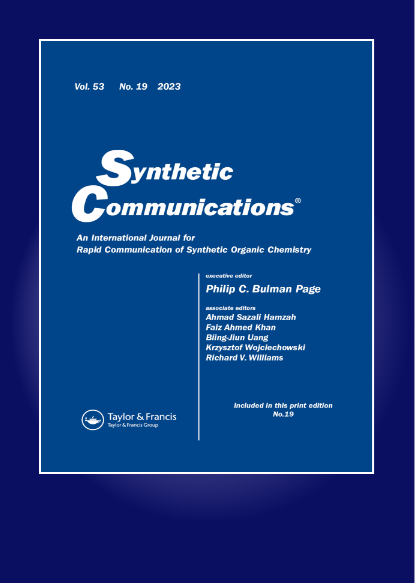在硫酸肼催化下通过 Biginelli 反应前所未有地一步合成 3,4-二氢嘧啶-2-(1h)-酮、ADMET 特性、分子对接研究及其对布氏杆菌和大肠杆菌的抗菌活性
IF 1.8
3区 化学
Q3 CHEMISTRY, ORGANIC
引用次数: 0
摘要
使用 20 mol% 的硫酸肼作为催化剂,通过醛、β-酮和脲或硫脲的单锅三组分缩合合成 3,4-二氢嘧啶-2(1H)-酮的方法变得更加简单高效。在回流条件下,醛、β-酮酯和脲在硫酸肼存在下进行环缩合,在乙醇中生成二氢嘧啶。与传统的 Biginelli 反应条件相比,使用硫酸肼作为催化剂的优点包括产率高(80-91%)、反应时间短(10-15 小时)。为了评估合成化合物的抗菌效率,我们研究了与对照组相比,合成化合物对革兰氏阳性(布氏芽孢杆菌)和革兰氏阴性(大肠杆菌)细菌菌株增殖的抑制作用。二氢嘧啶酮的不同衍生物对微生物的抑制率在 40-98% 之间。此外,还使用 SwissADME 等软件工具对合成的化合物进行了分子对接研究。本文章由计算机程序翻译,如有差异,请以英文原文为准。
Unprecedented one-pot synthesis of 3,4-dihydropyrimidine-2-(1h)-ones catalyzed by hydrazine sulfate through Biginelli reaction, ADMET property, molecular docking studies and their antibacterial activity on Bacillus brevis and E. coli
The syntheses of 3,4-dihydropyrimidin-2(1H)-ones by one-pot, three-component condensation of aldehydes, β-ketoesters and urea or thiourea have been made more simple and efficient by using 20 mol% hydrazine sulfate as catalyst. Aldehydes, β-ketoesters and urea are cyclocondensed in the presence of hydrazine sulfate to produce dihydropyrimidines in ethanol under reflux conditions. The advantages of using hydrazine sulfate as a catalyst over the traditional Biginelli reaction conditions include outstanding yields (80–91%) and a shorter (10–15 hours) reaction time. In order to evaluate the antibacterial efficiencies of the synthesized compounds, we have studied the inhibitions of microbial proliferation of both Gram-positive (Bacillus brevis) and Gram-negative (E. coli) bacterial strains in comparison to a control group. The microbial inhibitions occur in the range of 40–98% by different derivatives of dihydropyrimidinones. Molecular docking studies of the synthesized compounds have also been done using software tools such as SwissADME.
求助全文
通过发布文献求助,成功后即可免费获取论文全文。
去求助
来源期刊

Synthetic Communications
化学-有机化学
CiteScore
4.40
自引率
4.80%
发文量
156
审稿时长
4.3 months
期刊介绍:
Synthetic Communications presents communications describing new methods, reagents, and other synthetic work pertaining to organic chemistry with sufficient experimental detail to permit reported reactions to be repeated by a chemist reasonably skilled in the art. In addition, the Journal features short, focused review articles discussing topics within its remit of synthetic organic chemistry.
 求助内容:
求助内容: 应助结果提醒方式:
应助结果提醒方式:


